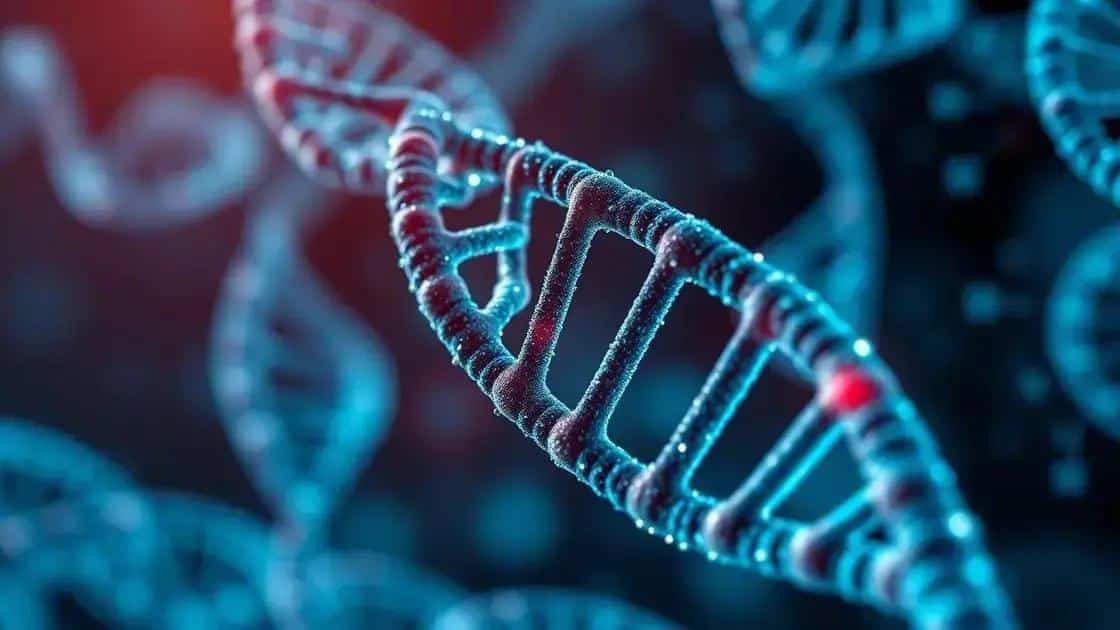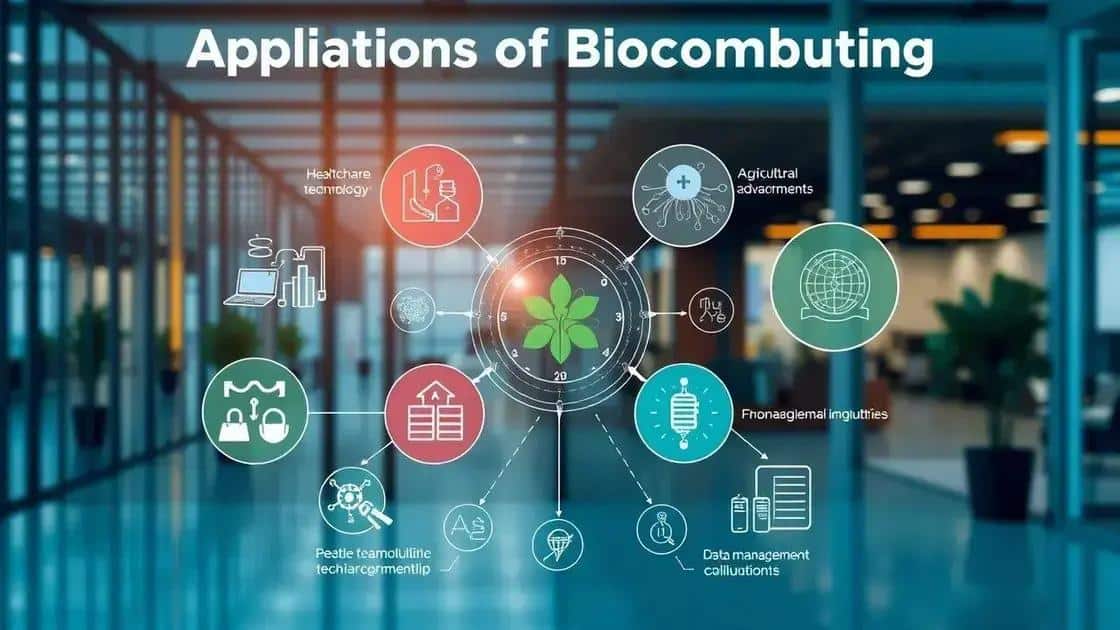Here’s how biocomputing works and matters for AI
Anúncios
Biocomputing integrates biological processes with computing technologies to enhance AI capabilities, leading to improved data processing, personalized solutions, and innovative applications across various industries.
Here’s how biocomputing works and matters for AI: this intriguing fusion of biology and computing is reshaping our technological landscape. Have you ever wondered how living organisms can enhance artificial intelligence?
Understanding biocomputing technology
Understanding biocomputing technology is essential in our rapidly evolving world. This field merges biological processes with computational systems, allowing us to solve complex problems in innovative ways.
At its core, biocomputing utilizes the natural processes of living organisms to perform computations. For instance, researchers are using DNA to store and transfer information, which opens new avenues in data management.
The Role of Biological Components
Biocomputing systems often rely on various biological components to function effectively. Here are key elements:
-
🧬 DNA: A molecule that carries genetic information, DNA is now being used in computational processes for data storage.
-
💻 Proteins: These can perform tasks similar to computer chips, enabling complex computations.
-
🧫 Cells: Biological cells can process information and respond to stimuli, making them crucial in biocomputing frameworks.
A unique advantage of biocomputing technology is its ability to work efficiently at a nanoscale. For example, biological systems can carry out many operations in parallel, which is much faster than traditional computers in some scenarios.
Applications in Real-World Scenarios
This technology finds various applications across multiple fields. Some notable examples include:
- Medicine: Biocomputing aids in drug development and personalized medicine.
- Environmental Science: It can help create systems for monitoring and managing ecological data.
- Data Storage: The potential for using DNA as a medium for massive data storage is revolutionary.
As we delve deeper into understanding this technology, it becomes clear how it can reshape fields. By blending biology and computing, we can tackle challenges that were once thought insurmountable. The future of biocomputing looks promising, paving the way for advancements in artificial intelligence and beyond.
The role of DNA in data storage

The role of DNA in data storage is a groundbreaking development in the field of biocomputing. By harnessing the unique properties of DNA, scientists are developing ways to store large amounts of information in a very small space.
DNA is a molecule that encodes genetic information, but it can also serve as an efficient storage medium. Each DNA strand can hold vast quantities of data, making it a potential solution for modern data storage challenges.
How DNA Works in Data Storage
When data is converted into DNA sequences, it can be synthesized and stored in the form of molecules. This process involves:
- Encoding Information: Data is translated into the four nucleotides (A, T, C, G) that make up DNA.
- Synthesis: Once encoded, the DNA can be created in labs using chemical processes.
- Storage: DNA can be preserved for long periods, remaining stable under proper conditions.
One major advantage of using DNA for data storage is its density. A single gram of DNA can theoretically store about 215 petabytes of data. This means that a small vial of DNA could hold all the data created in human history!
Current Research and Applications
Researchers are actively exploring various applications for DNA data storage. These approaches include:
- Archival Storage: DNA can effectively store historical documents and media.
- Cloud Computing: Future cloud systems may utilize DNA for efficient data retrieval and backup.
- Secure Information: DNA storage can be highly secure, providing protection against unauthorized access.
As the demand for data storage grows, the role of DNA will likely expand. Understanding how to harness these biological systems is critical for future innovations in technology and data management.
How biocomputing contributes to AI advancement
Biocomputing plays a significant role in the advancement of artificial intelligence (AI). By integrating biological systems with computational processes, researchers are unlocking new potentials for AI applications.
This fusion of biology and technology allows for more efficient algorithms and processes that can mimic natural intelligence. For example, biocomputing can simplify complex calculations that traditional computing struggles with.
Enhanced Data Processing
Through biocomputing, AI can benefit from enhanced data processing capabilities. Some of the key benefits include:
- Speed: Biological systems can process information much faster than current computer systems.
- Efficiency: Biocomputing reduces energy consumption, leading to more sustainable AI operations.
- Parallel Processing: Like a brain, biological systems can perform multiple tasks simultaneously, which helps in handling vast amounts of data.
This improvement in data processing also allows AI to learn more quickly and accurately, making it smarter over time. As researchers delve deeper into how biocomputing works, they discover ways to replicate these biological processes in artificial systems.
Applications in AI Development
The applications of biocomputing in AI are diverse and impactful. Some areas where they converge include:
-
🤖 Machine Learning: Biocomputing techniques are being applied to enhance machine learning models, making them more adaptive.
-
🧠 Natural Language Processing: Insights from biological intelligence are leading to better understanding of human language in AI.
-
🤖 Robotics: By using concepts from biocomputing, robots can be designed to learn and adapt in real time.
These advancements highlight the potential of biocomputing in AI, revealing how closely connected these two fields are. As technology continues to evolve, so too will the possibilities that arise from this synergy, pushing the boundaries of what AI can achieve.
Key applications of biocomputing in industry

Key applications of biocomputing in industry are transforming various sectors, enabling innovations that were once considered impossible. This technology integrates biological processes with computer systems to solve complex problems effectively.
In industries like healthcare, agriculture, and data management, biocomputing is making a significant impact. For instance, researchers are utilizing it to develop new medicines and improve crop resilience.
Healthcare Innovations
In the healthcare sector, biocomputing is being used to streamline processes and create personalized treatments. Important applications include:
- Drug Development: Biocomputing helps analyze genetic information to create tailored medications.
- Disease Modeling: Scientists use biological models to better understand diseases and develop effective therapies.
- Diagnostics: New technologies leverage biocomputing to enhance diagnostic accuracy and speed.
These applications illustrate how biocomputing can lead to breakthroughs in patient care and treatment efficacy. The synergy between biological systems and technology allows healthcare professionals to leverage data in ways that were not possible before.
Agricultural Advancements
Biocomputing also holds great potential in agriculture. Through this technology, researchers can develop crops that are more resilient and productive. Some key applications are:
- Genetic Engineering: Biocomputing aids in modifying crops for better yields and pest resistance.
- Resource Management: It optimizes the use of water and nutrients, leading to sustainable farming practices.
- Pest Control: Innovative solutions are developed to manage pests without harmful chemicals.
The integration of biocomputing in agriculture not only enhances food production but also contributes to environmental sustainability and resource conservation.
Data Management Solutions
In the realm of data management, biocomputing is proving to be a game-changer. Industries are adopting this technology to improve efficiency and security:
- Data Storage: Biocomputing techniques allow vast amounts of data to be stored securely in biological formats.
- Data Analysis: Biological algorithms help process and analyze large datasets quickly.
- Cybersecurity: Leveraging biological systems makes data protection more robust against cyber threats.
These key applications of biocomputing showcase its transformative potential across various industries. As technology continues to evolve, so too will the opportunities for innovation in industrial practices, fostering solutions that benefit society as a whole.
Ethical considerations in biocomputing
Ethical considerations in biocomputing are crucial as this technology evolves and integrates more deeply into society. As we harness biological processes for computational purposes, various ethical questions arise.
One major concern is the handling of genetic information. The ability to analyze and manipulate DNA raises important issues about privacy and consent. Individuals may not be fully aware of how their genetic data is being used.
Privacy and Data Protection
Protecting personal information is paramount in the field of biocomputing. Some key aspects include:
- Informed Consent: Individuals must understand how their data will be used before consenting to its collection.
- Data Security: Ensuring that genetic data is stored securely is essential to prevent unauthorized access.
- Transparency: Companies and researchers should be transparent about their data practices and policies.
These considerations aim to build trust between researchers and participants while fostering responsible practices in biocomputing.
Impact on Society
The societal impact of biocomputing extends beyond individual privacy. This technology can influence economic structures and health equity. For instance:
-
🌍 Access to Technology: There is a risk that only wealthy individuals or nations may benefit from biocomputing advancements.
-
⚖️ Genetic Discrimination: The potential for discrimination based on genetic data poses a serious ethical concern.
-
🧑🤝🧑 Public Understanding: Promoting a better understanding of biocomputing is necessary to ensure informed public discourse.
As the field progresses, it is vital to address these ethical implications. By prioritizing ethical practices, we can ensure that biocomputing develops in a way that benefits society as a whole, promoting innovation while safeguarding the rights of individuals.
Future trends in biocomputing and AI

Future trends in biocomputing and AI are expected to bring significant advancements that will shape various industries. As technology continues to evolve, the integration of biological systems with artificial intelligence will lead to more sophisticated solutions.
One trend gaining momentum is the development of smarter algorithms that mimic biological processes. By studying how nature solves problems, researchers can create AI systems that are more efficient and versatile.
Advancements in Data Processing
Future biocomputing methods will enhance data processing capabilities significantly. This will include:
- Speed Improvements: Biocomputing processes will operate faster, enabling real-time data analysis.
- Higher Efficiency: Leveraging biological systems will reduce energy consumption and improve sustainability.
- Integration of Diverse Data Sources: Combining data from multiple biological and digital sources can lead to better insights.
This shift will allow industries to react more swiftly to changes in real-time, improving decision-making processes across numerous fields.
Personalized Technologies
The trend towards personalization in healthcare and other areas will benefit from biocomputing technology. Expected advancements include:
- Personalized Medicine: Treatments tailored to individual genetic profiles will become more common.
- Customized Solutions: Businesses will use biocomputing to create products that fit the unique needs of consumers.
- Adaptive Learning Systems: Educational technology will harness biocomputing to adapt to each student’s learning style.
These personalized approaches will lead to better outcomes in healthcare and enhance customer satisfaction in other sectors.
Ethical and Regulatory Developments
As biocomputing grows, ethical considerations and regulations will evolve. Important aspects will include:
- Data Privacy: Ensuring that personal genetic information is protected will remain a priority.
- Ethical Guidelines: Developing standards for responsible use of biocomputing technologies is vital.
- Public Engagement: Involving the public in discussions about biocomputing implications will be essential.
Addressing these factors will help build public trust and ensure the responsible development of biocomputing and AI technologies.
In conclusion, future trends in biocomputing and AI promise to revolutionize various sectors with faster data processing, personalized solutions, and a focus on ethical practices, paving the way for innovative advancements that benefit society as a whole.
FAQ – Frequently Asked Questions about Biocomputing and AI
What is biocomputing and how does it relate to AI?
Biocomputing is the integration of biological processes with computing systems, helping to enhance AI systems by making them more efficient and capable of solving complex problems.
How will future trends in biocomputing affect healthcare?
Future trends are expected to lead to personalized medicine, where treatments can be tailored to individual genetic profiles, improving patient outcomes significantly.
What ethical considerations should be taken into account with biocomputing?
Important ethical considerations include data privacy, informed consent for genetic data usage, and ensuring equitable access to technology.
How can biocomputing improve data processing in industries?
Biocomputing can enhance data processing by allowing faster analysis, greater efficiency, and the ability to integrate diverse data sources for better insights.






